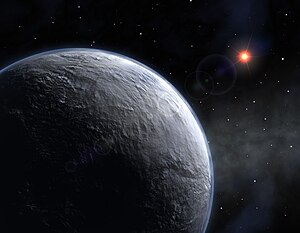OGLE-2005-BLG-390Lb
| Exoplanet | List of exoplanets | |
|---|---|---|
 |
||
| Parent star | ||
| Star | OGLE-2005-BLG-390L | |
| Constellation | Scorpius | |
| Right ascension | (α) | 17h 54m 19.2s |
| Declination | (δ) | −30° 22′ 38″ |
| Apparent magnitude | (mV) | 15.7 |
| Distance | 21,500 ±3,300 ly (6,600 ±1,000 pc) |
|
| Spectral type | M4V | |
| Mass | (m) | 0.22 M☉ |
| Radius | (r) | ~0.16 R☉ |
| Temperature | (T) | ~3000 K |
| Age | 9.587 Gyr | |
| Physical characteristics | ||
| Mass | (m) | 5.5+5.5 −2.7 M⊕ |
| Radius | (r) | 1.69 R⊕ |
| Temperature | (T) | 50 K (−220 °C; −370 °F) |
| Orbital elements | ||
| Semi-major axis | (a) | 2.0–4.1 AU |
| Orbital period | (P) | 3500 d (~10 y) |
| Observed separation | ||
| Projected separation | (d) | 2.6 AU |
|
Source-lens closest approach |
(t0) | 2,453,582.73 ± 0.005 JD |
| Angle of source motion | (α) | 157.9 ± 0.2° |
| Discovery information | ||
| Discovery date | 10 August 2005 | |
| Discoverer(s) |
PLANET/RoboNet, OGLE, MOA |
|
| Discovery method | Gravitational microlensing | |
| Discovery site | La Silla Observatory | |
| Discovery status | Published | |
| Other designations | ||
|
EWS 2005-BUL-390Lb, EWS 2005-BLG-390Lb
|
||
OGLE-2005-BLG-390Lb (known sometimes as Hoth by NASA) is a super-Earth exoplanet orbiting OGLE-2005-BLG-390L, a star 21,500 ± 3,300 light years from Earth near the center of the Milky Way. It is one of the most distant planets known. On 25 January 2006, Probing Lensing Anomalies NETwork/Robotic Telescope Network (PLANET/Robonet), Optical Gravitational Lensing Experiment (OGLE), and Microlensing Observations in Astrophysics (MOA) made a joint announcement of the discovery. The planet does not appear to meet conditions presumed necessary to support life.
The planet is estimated to be about five times Earth's mass (5.5+5.5
−2.7 M⊕). Some astronomers have speculated that it may have a rocky core like Earth, with a thin atmosphere. Its distance from the star, and the star's relatively low temperature, means that the planet's likely surface temperature is around 50 K (−220 °C; −370 °F), making it one of the coldest known. If it is a rocky world, this temperature would make it likely that the surface would be made of frozen volatiles, substances which would be liquids or gases on Earth: water, ammonia, methane and nitrogen would all be frozen solid. If it is not a rocky planet, it would more closely resemble an icy gas planet like Uranus, although much smaller.
...
Wikipedia
